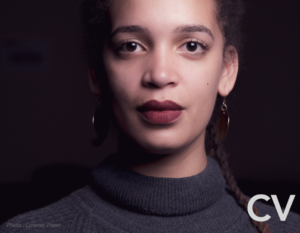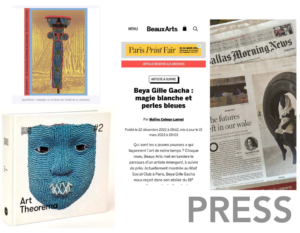BEYA GILLE GACHA
BIOGRAPHY
Beya Gille Gacha was born in Paris in 1990 to a Cameroonian mother and a French father. After a high school diploma in applied arts and Art History studies at the Ecole du Louvre, she decided to pursue an artistic career and developed a self-taught practice in contemporary art. In 2016, she set up the DES GOSSES collective with Neals Niat and Rakajoo to question the lack of representation of Afro-Europeans in the French artistic landscape. To date, her work has been exhibited at the Galleria Nazionale in Rome curated by Simon Njami, the Grand Palais in Paris alongside Barthélémy Toguo, the Musée du Quai Branly in Paris, the Musée National du Cameroun, the Dakar Biennale, the MAIF Social Club curated by COAL, and Untitled Miami with Galerie Keijsers Koning. Her work is included in the collections of the WorldBank and the Smithsonian Museum of African Art in Washington, the Fenix Museum in Rotterdam, the Bunker Art Space in Florida, and several private collections such as the Leridon Collection and Lucian Bennetton’s Imago Mundi Collection. In 2023, she had her first solo show at the Tropiques Atrium in Fort de France, curated by Salimata Diop. In 2024, she will notably be taking part in the Dakar Biennial as part of Curator Choice, entitled « On s’arrêtera quand la terre rugira » (« We’ll stop when the earth roars »), the Beelden Op de Berg Biennial in Wageningen, Netherlands, entitled « Decolonize Botany », and the exhibition « Mémoires, Genève dans le monde colonial » (« Memories, Geneva in the colonial world ») at the Musée d’Ethnographie in Geneva.
STATMENT
Beya Gille Gacha’s work is mainly anthropomorphic sculpture, recognisable by the use of glass beads to weave the skin. Her technique is a personal reinvention of the art of Bamiléké beadwork (the ethnic group from which her mother descends). For her, beading human beings is a way of valuing the individual and restoring the fundamental preciousness of the body. She uses moulding to create her sculptures. For her, this technique is a political act in its own right, because the history of moulding is not just a medical one: on female and racialised bodies, it is a history of violence, appropriation and objectification. She is therefore developing an inverse posture, tending towards the realm of care. The individuals they mould have the power to decide what will be done with their bodies. Their sculptures are intrinsically linked to their inner selves, while at the same time representing modern archetypes and addressing broader issues. Beya Gille Gacha’s practice evolves according to the symbols she gives to the materials she uses. Wax, for example, enables her to encrust beads to evoke skin; by studying and testing differen types and associations of this material, she turns her discoveries into the flesh and bones of these anthropomorphic sculptures. Her sculptures are associated with elements that are also defined according to her own language: from the use of colour to various objects, everything in Beya Gille Gacha’s work has a meaning, or rather several meanings. There is the overall reading of the stagings she creates with her works, and the different levels of reading that involve the associated objects, or the associated living beings. Beya Gille Gacha sometimes includes plants, minerals and other natural elements in her work. As part of her ecological exploration, she makes works using organic materials, second-hand materials and biomaterials, the latter representing a large part of her research. She also includes diverted objects, and the association of the different logics she establishes can be seen in both her sculptural work and her installation work, which is probably her 2nd most extensive practice. Video is also a medium she uses to create visual metaphors or personal reflections, often combined with her writing in OFF voice. In 2020, Beya Gille Gacha also began painting « medicinally ». These are abstract paintings in which the pigments are plants and spices chosen for their healing properties rather than for their colour. Produced exclusively on handmade paper, these paintings are the intuitive, spontaneous counterpart to her long and meticulous practice of sculpture At once realistic, symbolic and conceptual, Beya Gille Gacha’s work is intended to be accessible to all, without losing the intellectual depth from which this MENSA member cannot shy away. She champions contemporary art that echoes the living arts that are part of everyday life in many of the world’s cultures. For her, a work of art can be as much an art object as a votive object, a transitional object or a magical object. Beya Gille Gacha defines herself as an artist of connection. Her practice aims to define forms through which people can rediscover a sense of self, while at the same time tackling subjects that affect as many people as possible. She sees her creations as bridges that probe different sensibilities, in a poetic quest to illustrate where trees meet, where essence is hidden.

